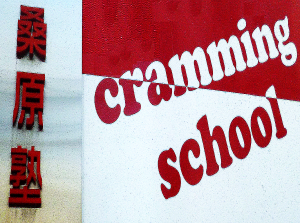Blunt Branding: Marketing Your Company Like It Really Is

There is, in this school’s branding, none of the soft and vexing ambiguity, vagueness and euphemisms for which the Japanese and their language are oft-noted.
Stumbling—actually, rolling—across it on my hotel’s loaner bike during another of my solo excursions,I had a moment of awe and an epiphany, in the form of contemplation of broader applications of “blunt branding”, especially at home, where being brutally frank seems to come to many of us so much more easily than to most Japanese.
So, why not?—Why not innovate and set a trend by getting on board with the idea of blunt branding—given that it is easy to see the benefits of doing so.
But before exploring those benefits, consider two things:
- the individual branding possibilities for products and services as well as the companies that offer them, and, most especially any company brand that is identified with the name of what it sells, e.g., Coca-Cola
- the constraint that the blunt branding must not turn off clientele and customers. For example, “cramming school” has, I am sure, masochistic, stoical appeal to Japan’s ever-sacrificing, always grimly determined “education mommas” (“kyoiku momma“) who live to live to see their offspring get into a springboard school that can catapult them into a prestigious, well-paid life niche.
Our equivalent concept, “preparatory school”, sounds wussy by comparison, as does the Japanese “yobiko“, its close equivalent.
Start with this second consideration, the constraint, which, as a standard or criterion, can be hard to meet. For example, it precludes bluntly re-branding Coca-Cola as “Tooth Acid”. However “Fizzy Sugar” might work, because “sugar” resonates with an ambivalence that the Japanese can and the rest of us do appreciate, since “Sugar”, as a term of endearment is as deeply rooted in our culture as advanced tooth decay. Call this slightly watered-down bluntness “Blunt Lite”.
On closer examination, “Cramming School” is tinged with a similar ambivalence, to the extent that it resonates both favorably (with the education mommas) and unfavorably (with their kids), thereby at least capturing collective, if not individual Japanese ambivalence.
Blunt Branding and Bisociation
This central role of ambivalent branding in blunt branding suggests that the underlying advertising creative principle here is what I have explained in other articles of mine as what Arthur Koestler dubbed creative “bisociation” —the technique of creating something very interesting (and, when marketed, also profitable) by integrating or synthesizing what are ostensible opposites.
For example, the Disney Corporation has made billions by branding Mickey Mouse, who or which is fundamentally a mouse that is not a mouse, and about whom there is an unconscious deep ambivalence (at least among the legions of girls who worship Mickey and treasure the merchandise that displays or embodies him).
That ambivalence is succinctly encapsulated in two predictable shrieks typical of young girls: “Oooo! Mickey!” and “Eeew!—a mouse!” (“Eeek!” being the most common variant of “Eeew!”.)
It’s the same with the very successful “Twilight” vampire brand: “Eeek!—a vampire!” and “Oooo!—a (hunky/foxy) vampire!”
It may be that “Blunt Classic” might work too—that is, a branding without positive and negative resonances, featuring only pure negatives, such as “Tooth Acid” would. The payoff would be public and consumer appreciation of the raw corporate honesty: “Hey, it’s tooth acid, but the company has integrity!”
Rebranding the Fortune 500
With these two models in mind—”Blunt Lite” and “Blunt Classic”, and not being overly strict about a perfect match between corporate and product names, while applying the bisociation principle conceptually, if not emotionally, let’s have a go at some blunt branding:
—Nike gets rebranded as “Pricey” and its slogan “Just do it!” becomes “Just do it, fool!”
—Mercedes Benz becomes “Mercedes Exbensive”.
—Kent cigarettes becomes “Kentcer” (for an obvious reason).
—Lucky Strike becomes “Unlucky Stroke” (as in “cerebral stroke”).
—Facebook becomes “Facehook” (which makes Facebook’s addictive, narcissistic appeal obvious), or “Fakebook” (because, as a recently disenchanted friend of mine put it, “People fake and craft identities to make themselves look better than they are.”).
—Twitter is simply shortened to “Twit” (given how vapid so many tweets tend to be).
—J.P. Morgan-Chase, of course, becomes “J.P. More Gain-$Chase”.
—Sucralose is tweaked into “Sucraloser” (suggesting it’s more of a wobbly crutch for grease and sugar-addicted losers than for losing weight).
—Monsanto, naturally, becomes “Moninsanity” or “MonSatan” (because of environmentalist, medical practitioner and nutritionist outrage over alleged toxicity, sterility, etc., problems with its GMO products, without even getting started on Vietnam war-era dioxin and Agent Orange).
—Fortune 500 is rebranded as “Silverspoon 500” (an allusion to and admission of the role family wealth plays in getting and staying on that list).
You get the idea.
Ah, one more. What about Recruiter.com?
I propose “Recruiter.com”…
…because you can’t become more blunt when you’re already telling the absolute truth.
____________
Note: This is another in a series of Japan and Taiwan-themed articles by Michael Moffa while “on the road” there.

